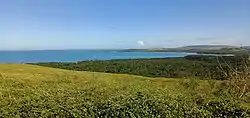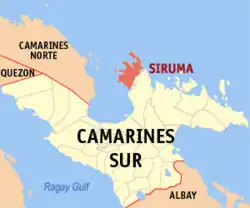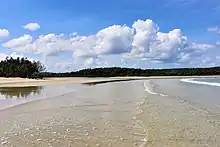Siruma
Siruma, officially the Municipality of Siruma (Central Bikol: Banwaan kan Siruma; Tagalog: Bayan ng Siruma), is a 4th class municipality in the province of Camarines Sur, Philippines. According to the 2020 census, it has a population of 19,419 people.[3]
Siruma | |
|---|---|
| Municipality of Siruma | |
 View from Siruma View Deck | |
 Flag | |
 Map of Camarines Sur with Siruma highlighted | |
OpenStreetMap | |
.svg.png.webp) Siruma Location within the Philippines | |
| Coordinates: 14°01′19″N 123°15′32″E | |
| Country | Philippines |
| Region | Bicol Region |
| Province | Camarines Sur |
| District | 4th district |
| Barangays | 22 (see Barangays) |
| Government | |
| • Type | Sangguniang Bayan |
| • Mayor | Carina R. Polinga |
| • Vice Mayor | Sandy S. Ondis |
| • Representative | Arnulf Bryan B. Fuentebella |
| • Municipal Council | Members |
| • Electorate | 14,402 voters (2022) |
| Area | |
| • Total | 141.27 km2 (54.54 sq mi) |
| Elevation | 11 m (36 ft) |
| Highest elevation | 134 m (440 ft) |
| Lowest elevation | −1 m (−3 ft) |
| Population (2020 census)[3] | |
| • Total | 19,419 |
| • Density | 140/km2 (360/sq mi) |
| • Households | 4,262 |
| Economy | |
| • Income class | 4th municipal income class |
| • Poverty incidence | 37.77 |
| • Revenue | ₱ 98 million (2020) |
| • Assets | ₱ 190.3 million (2020) |
| • Expenditure | ₱ 70.02 million (2020) |
| • Liabilities | ₱ 10.41 million (2020) |
| Service provider | |
| • Electricity | Camarines Sur 2 Electric Cooperative (CASURECO 2) |
| Time zone | UTC+8 (PST) |
| ZIP code | 4427 |
| PSGC | |
| IDD : area code | +63 (0)54 |
| Native languages | Central Bikol Tagalog |
| Crime index | 0 |
| Website | crohan |
History
Siruma belonged to several towns before it became an independent town of its own. Years back, the municipality of Siruma was under the jurisdiction of Quipayo, considered to be one of the oldest parishes in the Archdiocese of Nueva Caceres. Now, Quipayo is a barangay of Calabanga town.
On October 19, 1846, a decree was implemented by Governor General Narciso Claveria which restructured the territorial domain of the province. It was during this time that Siruma was ceded to Camarines Norte.
It was said that the town's name was derived from the name of an island called "Matandang Siruma". The word "siruma" comes from the local vernacular sirum which is a "small, red ant". A myth was told that a certain capitan encountered a swarm of small red ants during his overnight stay in one of the places in Siruma, thus, calling the place as "masirum".
Geography
Barangays
Siruma is politically subdivided into 22 barangays. Each barangay consists of puroks and some have sitios.
- Bagong Sirang
- Bahao
- Boboan
- Butawanan
- Cabugao
- Fundado
- Homestead
- La Purisima
- Mabuhay
- Malaconini
- Matandang Siruma
- Nalayahan
- Pinitan
- Poblacion
- Pamintan-Bantilan
- Salvacion
- San Andres
- San Ramon (Daldagon)
- Sulpa
- Tandoc
- Tongo-Bantigue
- Vito
Climate
| Climate data for Siruma, Camarines Sur | |||||||||||||
|---|---|---|---|---|---|---|---|---|---|---|---|---|---|
| Month | Jan | Feb | Mar | Apr | May | Jun | Jul | Aug | Sep | Oct | Nov | Dec | Year |
| Average high °C (°F) | 31 (88) |
30 (86) |
33 (91) |
35 (95) |
36 (97) |
36 (97) |
35 (95) |
34 (93) |
35 (95) |
33 (91) |
32 (90) |
31 (88) |
33 (92) |
| Average low °C (°F) | 27 (81) |
27 (81) |
28 (82) |
30 (86) |
31 (88) |
31 (88) |
30 (86) |
30 (86) |
30 (86) |
29 (84) |
28 (82) |
28 (82) |
29 (84) |
| Average precipitation mm (inches) | 62.63 (2.47) |
114.71 (4.52) |
41.44 (1.63) |
56.32 (2.22) |
105.22 (4.14) |
175.86 (6.92) |
192.89 (7.59) |
110.61 (4.35) |
130.78 (5.15) |
546.13 (21.50) |
232.9 (9.17) |
462 (18.2) |
2,231.49 (87.86) |
| Average rainy days | 21 | 25 | 14 | 17 | 23 | 29 | 31 | 23 | 27 | 29 | 29 | 31 | 299 |
| Source: World Weather Online (modeled/calculated data, not measured locally)[5] | |||||||||||||
Demographics
|
| |||||||||||||||||||||||||||||||||||||||||||||||||||
| Source: Philippine Statistics Authority[6][7][8][9] | ||||||||||||||||||||||||||||||||||||||||||||||||||||

In the 2020 census, the population of Siruma, Camarines Sur, was 19,419 people,[3] with a density of 140 inhabitants per square kilometre or 360 inhabitants per square mile.
Economy
References
- Municipality of Siruma | (DILG)
- "2015 Census of Population, Report No. 3 – Population, Land Area, and Population Density" (PDF). Philippine Statistics Authority. Quezon City, Philippines. August 2016. ISSN 0117-1453. Archived (PDF) from the original on May 25, 2021. Retrieved July 16, 2021.
- Census of Population (2020). "Region V (Bicol Region)". Total Population by Province, City, Municipality and Barangay. Philippine Statistics Authority. Retrieved 8 July 2021.
- "PSA Releases the 2018 Municipal and City Level Poverty Estimates". Philippine Statistics Authority. 15 December 2021. Retrieved 22 January 2022.
- "Siruma, Camarines Sur: Average Temperatures and Rainfall". World Weather Online. Retrieved 29 October 2017.
- Census of Population (2015). "Region V (Bicol Region)". Total Population by Province, City, Municipality and Barangay. Philippine Statistics Authority. Retrieved 20 June 2016.
- Census of Population and Housing (2010). "Region V (Bicol Region)" (PDF). Total Population by Province, City, Municipality and Barangay. National Statistics Office. Retrieved 29 June 2016.
- Censuses of Population (1903–2007). "Region V (Bicol Region)". Table 1. Population Enumerated in Various Censuses by Province/Highly Urbanized City: 1903 to 2007. National Statistics Office.
- "Province of Camarines Sur". Municipality Population Data. Local Water Utilities Administration Research Division. Retrieved 17 December 2016.
- "Poverty incidence (PI):". Philippine Statistics Authority. Retrieved December 28, 2020.
- "Estimation of Local Poverty in the Philippines" (PDF). Philippine Statistics Authority. 29 November 2005.
- "2003 City and Municipal Level Poverty Estimates" (PDF). Philippine Statistics Authority. 23 March 2009.
- "City and Municipal Level Poverty Estimates; 2006 and 2009" (PDF). Philippine Statistics Authority. 3 August 2012.
- "2012 Municipal and City Level Poverty Estimates" (PDF). Philippine Statistics Authority. 31 May 2016.
- "Municipal and City Level Small Area Poverty Estimates; 2009, 2012 and 2015". Philippine Statistics Authority. 10 July 2019.
- "PSA Releases the 2018 Municipal and City Level Poverty Estimates". Philippine Statistics Authority. 15 December 2021. Retrieved 22 January 2022.